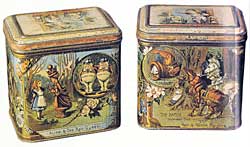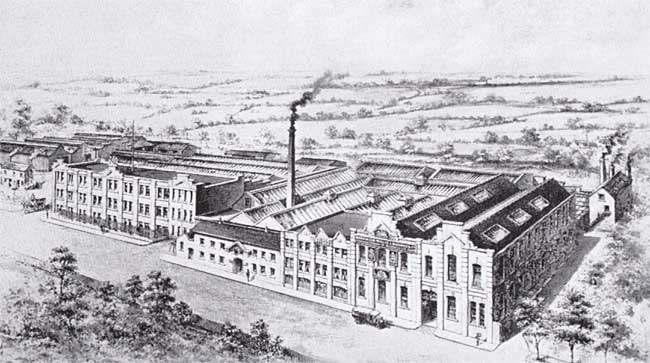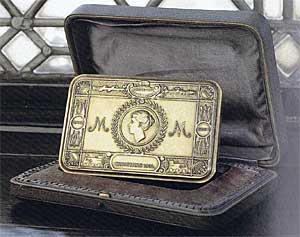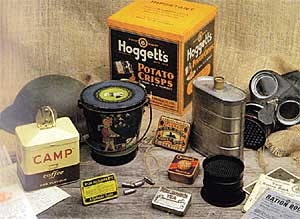
Barringer, Wallis and Manners - Metal Box Company – Crown Speciality Packaging
If you have a metal sweet tin, a tobacco tin, tea caddy or a cake tin in your house the chances are that it was made by the Metal Box Company Rock Valley, Mansfield and Oddicroft Lane, Sutton in Ashfield. The Rock Valley plant moved in 2010 to Crown Farm Way, Forest Town and still manufactures “speciality tins” such as Biscuits/Tea Caddy/Whisky. The Sutton plant manufactures aerosols only. The Carnaud Metalbox name does not exist anymore, it was taken over by Crown Cork & Seal in 1996 and the two names were kept for a while. Now, the company is only known as CROWN Holdings Inc, the world’s largest metal packaging company and operates 4 divisions: CROWN Speciality Packaging, CROWN Aerosols, CROWN Bevcan and CROWN Foodcan. The manufacture of food and beverage cans also takes place at other plants.
The company grew out of a local spice and condiment grinding firm owned by David Cooper Barringer in the 1830s. Mustard seed milling was included in the spice grinding and it believed that had been carried on in the area since the 1820s. It was marketed in wooden kegs for larger quantities and in smaller tins. The tins were initially made in small numbers by hand. Upon David’s death his brother Robert purchased the business and later his son, Walter joined the company. In 1873 a fire in the Valley destroyed many of the buildings but the mustard mill and tin shop were spared and allowed Barringer to expand his business by marketing tin boxes with decorated surfaces. Prior to this the tins were decorated with coloured paper labels stuck onto them. In 1897 Issac Henry Wallis joined the firm and was renamed Barringer and Company. The company began to develop the idea of decorating the metal tins and boxes and Queen Victoria’s Jubilee was a great opportunity to impress with a pictorial box.

Alice in Wonderland tin box (image courtesy of CSP).
Robert Barringer retired in 1889 and was replaced by his son in law, Charles Manners. The tin-box making business was separated from the milling side and developed in its own right. The application of coloured transfers, as in the decorating of pottery, had supseded the sticking on of prints. In 1892 a lithographic printing plant was installed to produce the prints. Tinplate printing uses an offset lithographic process, meaning that the inked image on the plate does not print directly onto the tinplate but is first ‘offset’ onto a rubber blanket and then transferred onto the final surface. One of the first ventures was the black and gold design of the ‘Players Navy Cut’ tobacco tin and a century later the company was still producing tins for the tobacco industry. Players and Berringer Wallis and Manners worked closely together and in 1895 two members of the Players family bought shares in the company. In 1891 searching for a novel idea for a Christmas biscuit tin the company approached Lewis Carroll for permission to use the illustrations for Alice in Wonderland. Initially he declined but later gave his permission. There is a great deal of correspondence between Lewis Carroll and Miss Mary E Manners regarding this matter but in the end he was very pleased with the outcome and in fact asked for some of his friends to be sent boxes.
The number of staff members had risen from 50 to 143 in a matter of a few years and mustard milling and tin box manufacture had been completely separated by 1895 when the company was incorporated under the title Barringer Wallis and Manners. Some years later the mustard milling was sold to Colmans of Norwich. The remaining works in Rock Valley were turned over to tin printing and the manufacture of tin boxes.

Rock Valley Works, c.1914 (image courtesy of CSP).
Considerable building extension was carried out at the Rock Valley works as well as the acquisition of a factory at Oddicroft Lane, Sutton in Ashfield. A Clock tower and tower block were built in 1919 which remains a feature today. The laying of the foundation stone for this building attracted considerable attention. However, the high watermark for the company was in 1914 with the visit of King George V and Queen Mary, together with the Duke and Duchess of Portland to the toy factory at Rock Valley. In celebration of this event an arch was constructed at the entrance to the toy factory, topped with carved unicorns and bearing the Barringer Wallis and Manners coat of arms. Unfortunately the royal couple did not see this as they entered from a different direction! The manufacture of children’s toys was launched because during the First World War supplies from abroad were curtailed and it was decided to produce them at Rock Valley. Clockwork motor cars, engine, aeroplanes and other metal toys were produced for the pleasure of children.

Christmas tin of chocolates sent to the troops in 1914 by Princess Mary (image courtesy of CSP).
Barringer Wallis and Manners produced tins for royalty including Queen Victoria’s chocolate tin sent to troops during the Boer War and Princess Mary’s boxes which were sent to troops in 1914 became legendary. Celebration tins were also made for coronations and wedding of the various royals. The company was proud of the fact that they were the only tin-box manufacturers to be granted a series of Royal Warrants, bestowed by Queen Victoria, Edward VII, George V and King Albert I of Belgium.
The Boer War (1899-1902) and World War One (1914-18) saw the company heavily involved in producing a variety of tins for items as diverse as gas mask containers to food and tobacco tins for the troops. The company had always employed a large proportion of women and girls, so during the First World War when men were going to the Front it was possible to keep the factory fully staffed. By the beginning of the war several of the original members of the company had died; Robert Barringer and Charles Manners in 1905 and Walter Barringer in 1912. During his lifetime, Robert had been an Alderman of Mansfield and was involved in organizing Mansfield’s celebrations for Queen Victoria’s Diamond Jubilee.
A key to their success was the artistic designs and general workmanship of the products. The artist’s studio employed highly qualified designers and the engineering department had craftsmen who were developing press tools and took a pride in their work. Not all the production was mechanized there was still some hand-made models. All samples were packed with meticulous care in blue velvet and stout cardboard boxes. One of the artists employed on a contract basis at the firm was Charles Fletcher designed the ‘Quality Street’ range of containers which still exist today. Charles Manners was very much involved in the art side of the company and he was instrumental in improving the premises of the Mansfield School of Art. A special catalogue, issued in 1915/16, indicated the diversity of products: ‘Moscow’ handkerchief box; ‘Petrograd’ glove box; ‘Telephone call’ box (moneybox); British Empire box. As well as these luxury items the company produced tins for tobacco, cigarettes, snuff, pills, health salts, ointment, pen nibs, gramophone needles, typewriter ribbons, screws, nails and many other items. Something which is becoming less well known is the talcum powder tin. This provided a good source of business providing for Coty, Yardleys, Boots and Cussons and the tins were manufactured to a high standard of decoration and tightness of the seams.
The company was able to ride out the worst of the ‘Depression’ through the growing metal toy industry and also the desire for decorative metal boxes, especially commemorative ones. However, the bulk of their work was producing biscuit and tea containers with different shapes, designs and decoration. There was also competition in the form of the Metal Box Company and eventually Barringer Wallis and Manners joined Metal Box in 1939. During the 1930’s the company started up the Extrusion business (the process of producing moulded sections of plastic or metal by ejection from a shaped nozzle or die) at the Mansfield plant making toothpaste tubes, using pure tin, which was later changed to aluminum extrusion in 1945.

Tins produced during World War 2 (image courtesy of CSP).
The outbreak of the Second World War brought fresh challenges to the company. As in the First World War the resources of both sites were put at the Government’s disposal for the manufacture of essential war supplies. In addition to providing containers for food and ammunition and gas masks, the Sutton plant was contracted to manufacture the Very pistol for signaling and the Boyes Anti-Tank rifle. The company’s skill with pressed metal plate enabled them to undertake the manufacture of Sten guns. The innovation of the company was highlighted in their production of multi-purpose boxes, such as sweet tins which could double as children’s seaside buckets and Camp Coffee containers which could later be used as string dispensers. These innovations fitted into the ‘Make do and Mend’ notion during the war years.
At one of the most critical periods of the war, the Battle of Britain, the Metal Box group joined a scheme to raise the cost of building a Spitfire, so important in winning this battle. They raised £5000 and in May 1941, Spitfire Mk2, serial P8389 had been purchased and was named ‘Metalbox’. It survived the war and became a training aircraft and was finally scrapped in 1947.
In that same year, spare land at the Sutton site was earmarked for building the ‘Open Top’ factory providing cans to the local food canning industry. This was the production of cans with the tops left off, which were then filled, sealed and processed by the food company. Batchelor’s Peas of Sheffield was one of the major users of this type of tin. It helped that both Sutton and Sheffield and the suppliers of the tinplate in Neath, South Wales were all closely linked to the railway. The railway also took containers from Sutton to the Kit-e-Kat factory at Melton Mowbray.
Alongside this the company was improving their printing technology and at the Sutton factory undertook the production of Chad Valley metal toys. This was in a time when tin plate was in short supply and rationed but with the Coronation in 1953 the demand for souvenir tins was so great that the company had to purchase a factory in Leicester in order to supplement production.
The company’s production of biscuit and confectionary boxes continued to be the core of the business but there were already signs that competition was growing in this market and Metal Box began to manufacture aerosol cans; the first commercial aerosols was for insecticides in the 1950s. They had a shallow aluminum extruded body, which was closed after filling by seaming on a concave end in which a valve had already been soldered. This type was replaced by the Trimline cans of today. The Sutton plant became a dedicated aerosol can manufacturer and continues to be so today.
Unfortunately changes in lifestyles saw the returnable standard biscuit tin phased out in the mid 1960s.This was where shops sold biscuits from a tin, rather than today where biscuits are packaged ready for sale. The demand for fancy boxes also declined in this period and a period of rationalization took place over the next few years with some job losses and movement of production of the more unprofitable goods, such as talcum powder tins, being moved elsewhere other than Mansfield or Sutton. During the 1960s the company was always looking for new products and an order for 5,000,000 table mats was placed by Proctor and Gamble which not only kept the factory busy it created better ways of tooling and manufacturing fancy boxes.
Over the next ten years the company had some setbacks to their production. In August 1967 a fire swept through the printing department at Sutton causing damage and affecting the jobs of about 100 men. Again, in September 1969 a large fire, estimated at causing many thousand pounds worth of damage, virtually gutted a two-storey building, one of the original buildings of the Barringer Wallis and Manners factory, which contained the printing and reproduction departments at the Sutton factory. The fires were often attributed to the fumes from the printing department going through ducting into the atmosphere. Although the Mansfield factory relied on the printed tinplate from Sutton, efforts were made to keep supplies coming from other Metal Box factories. The fire had actually given the company an opportunity to modernize and create the latest means of production. The Sutton site was restored in record time. A dispute at the factory in 1977 over first aid cover, contributed to reduced profits in 1978, according to the Chairman of the company, Sir Alex Page. The Sutton plant is still situated on the same original site, albeit it is now smaller as recreational grounds were sold off and have now been replaced by industrial units. The site is fully mechanized and wholly used for the manufacture of aerosol containers, the main customer was Gillett but other companies are now included.
The recreational fields were used by the whole company UK wide for sports such as cricket, football and tug-of-war and families travelled to see their families taking part. As the fields were sold off so the sporting activities declined.
In 1975 over 3000 people were employed by the company in Mansfield and Sutton, many of them women. Students were also taken on during the summer months. The company attracted workers who stayed with them for many years and many presentations took place in recognition of long service, retirement and proficiency in various aspects of the business. In 1976 half a million pounds worth of business was awarded to the company by a Dutch manufacturer for 450,000 gingerbread tins and 600,000 cocoa tins. They were also moving towards plastic screw on caps for Marmite and Bovril in place of metal lids. Another innovation was for the production of pressurized tins containing tennis balls for the American market. In 1977 the company went back to their roots to produce commemorative items, in particular a tray portraying the Queen and Prince Philip for the Queen’s Silver Jubilee. More than 300,000 of the trays were marketed both at home and in the Commonwealth.
During the last thirty years the company has experienced highs and lows associated with manufacturing. In 1983 and again in 1999 the company had to make redundancies because of downturns in the market. Nevertheless the company has survived, albeit under the different name of CarnaudMetalbox, part of Crowncork and now Crown. Oddicroft Lane in Sutton is now a site which produces only aerosol cans, whereas the Mansfield site which moved to Crown Farm Way, Forest Town, 3 years ago produces specialty packaging. The Mansfield site employs 100 people on the production side, although there are a further 45 employed by the Divisional side and there are about 400 people working at the Sutton site.
Acknowledgements
Many thanks to Marg Thorne at Sutton in Ashfield library for all her help.